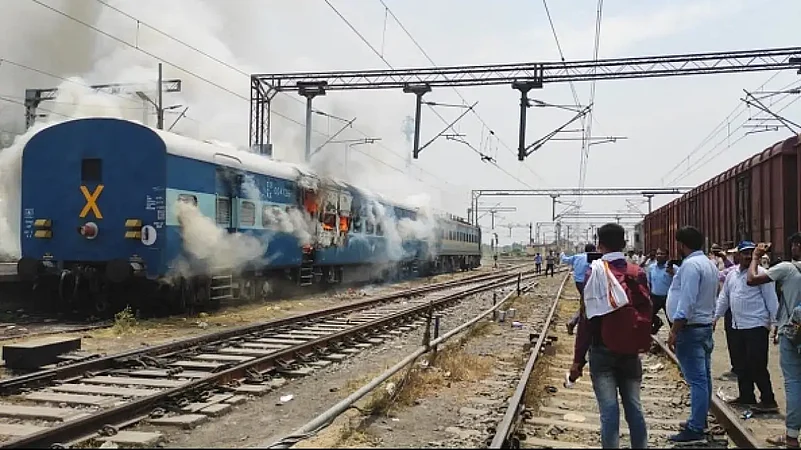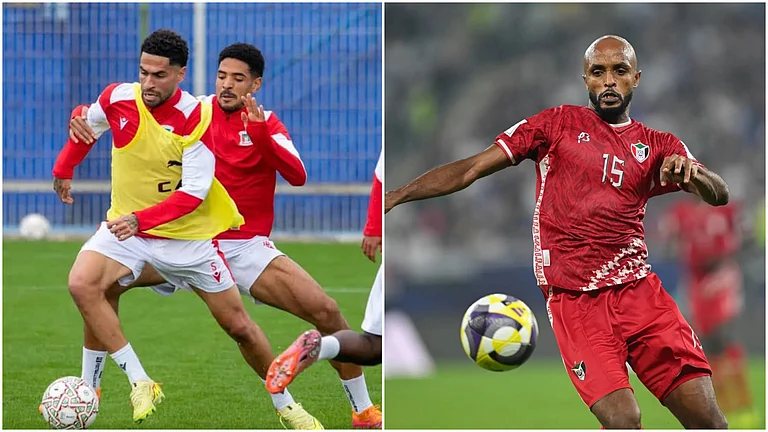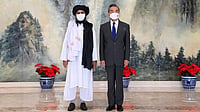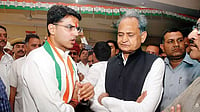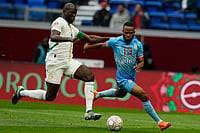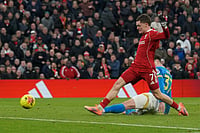Days after its unveiling, the Agnipath recruitment scheme snowballed into a controversy as protests rocked several cities of the country. The disgruntled army aspirants hit the streets and poured out their resentment. Traffic was blocked, trains set ablaze, and windscreens of cars smashed, while the police resorted to aerial firing and baton charge. At some places, the administration quickly snapped internet in a bid to contain any miscommunication.
Under the scheme, youth in the 17.5 to 21 age group would be recruited for the armed forces, but the contract would not go beyond the tenure of four years in 75 per cent of the cases. Only 25 per cent of the recruits, aka Agniveers, would be required to continue for 15 more years under permanent commission. In other words, around 45,000 to 50,000 soldiers will be recruited annually, out of which 33,750 to 37,500 would have to leave the service after four years.
Agniveers will get an initial salary of Rs 30,000 with additional benefits that could together amount to Rs 40,000 by the end of the four-year service. Thirty per cent of the soldier’s salary will be set aside under a Seva Nidhi programme, and the government will contribute an equal amount every month, and at the end of the tenure of four years, the soldier will get a tax-free sum of Rs 11.71 lakh as severance gratuity.
Owing to the pandemic, the army put recruitments on hold for the last two years, which has left millions of aspirants frustrated because they might soon be too old to apply for jobs in the army.
The announcement of the reforms in the army recruitment process comes around the time when India is battling severe unemployment, and the wholesale inflation has touched a record 15.88 per cent, and while the Indian rupee is at an all-time low against the US dollar. The reforms are aimed at cutting the army's expenditure on bloating salaries and pensions that consume more than half of its budget, and the freed-up funds will likely be allocated to modernising the military.
Air Vice Marshal Kapil Kak (retired) tells Outlook, “Nearly 23 per cent of the defence budget would go into the disbursement of pensions, which means this scheme will free up a lot of resources that can be used for much-needed and long-awaited modernisation of the military and its infrastructure.”
Mixed opinions
Not all veterans, security officials, and defense experts are happy about the Agnipath plan. Even Major General G.D. Bakshi (retired), who is otherwise an all-weather supporter of the government's policies on prime-time news shows, was “flabbergasted” by the policy. He went on further pleading with the government in his Twitter post: “For Gods sake. PLEASE DON'T do it” .
After recruitment, the Agniveers will undergo six months of training before being deployed for duty. But veterans are worried that training for merely six months might affect the operational capabilities of the forces.
“The training they (Agniveers) will get is going to be rudimentary,” says the military analyst Major General Amrit Pal Singh (retiredd), while adding, “in combat situations, they will end up being a burden on other seasoned troops.” The veteran tells Outlook that the Agniveers will only fill basic ranks in the military, and as such, the army will be fraught with a scarcity of skilled manpower for years to come.
“We will have skilled personnel, who have undergone extensive training and are tech-savvy only after a period of five to six years,” says Major General Amrit Pal Singh, who has headed the training vertical of Army Training Command (ARTRAC) for over two-and-a-half-years. "By the time an Agniveer acquires a certain skillset; he would be set for departure from the services, only to create a vacancy to be filled by another potential recruit all over again,” he adds.
Where will the demobilised go?
According to the new scheme, after serving four years on the job, 75 per cent of the soldiers will be discharged from their services, and only 25 per cent would be re-inducted into the armed forces. Numerically speaking, after the four-year tenure, three out of every four Agniveers would be demobilised, which would, in turn, render them jobless. The question remains: where will these men go?
Allaying these fears a day after the scheme was unveiled, Union Home Ministry announced that the successful exiting soldiers will be given priority in recruitment for the Central Armed Police Forces (CAPFs) and Assam Rifles. Similarly, the demobilised Agniveers will be given preference in police recruitment, according to the Chief Ministers of Uttar Pradesh, Madhya Pradesh, and Assam, while the Haryana chief minister said the state would offer them “preference in occupations and other duties".
Although the governments of the above-mentioned states have promised the preference for jobs, there is no guarantee whether the promises will see the light of the day. The government further maintains that during their period of service, the Agniveers will learn skills during their service, which will help them in finding jobs after they are discharged.
“Do corporates hire sharpshooters? Because, using arms and ammunitions, and dealing in combat situations are the skills one learns in the army, is that it?” Lieutenant Colonel Anil Duhoon (retd) asks, with a tinge of satire. The veteran feels that the government should rather “guarantee” jobs to aspirants than promising them a mere “preference”.
Echoing the retired Lieutenant Colonel's fears, a protester in Bihar’s Munger was quoted by a news agency as saying, “Nobody will go to the Army just for four years” .
Veterans like Air Vice Marshal Kapil Kak fear that the discharged lot of Agniveers who would be returning from service with arms and combat training might pose a threat of ‘militarisation’ of the society. Major General GD Bakshi took to Twitter on Wednesday and wrote: “If trained a young military manpower released is not absorbed it could join terrorists or insurgents”.
In an article he wrote for Al Jazeera, Sushant Singh, a Senior Fellow at Centre for Policy Research in New Delhi, expressed similar qualms. “The demobilised short-term contractual soldiers,” writes Singh, “could provide a major recruiting pool for such [Hindutva] groups who wish to use violent means to pursue their ideological goals. Singh goes on further writing that the “consequences of such an eventuality will be catastrophic,” and that the “some of the more ominous warnings about the safety of the country’s religious minorities could eventuate”.
Is this the time for tinkering?
Since the Modi government assumed power in its second term, India has remained perpetually mired in a “no-peace-no-war” kind of a situation. While having belligerent Pakistan on the one side and the ‘far-more-advanced’ People's Liberation Army (PLA) on the other—not to forget the insurgency in the erstwhile state of Jammu and Kashmir—several veterans and defence analysts feel that by tinkering with the military structure amid these times, India might face problems.
India and China have been locked in a military stalemate along the Line of Actual Control (LAC) in Ladakh region since April 2020. As China demonstrated its malicious plans once again, after starting building a second bridge on the Pangong Tso lake in May, the Border Roads Organisation (BRO) hastened the work on the road connecting Nubra Valley to the DBO in a bid to facilitate the swift mobility of the Indian forces in the region.

An ex-army official tells Outlook that demand for the manpower has shot up since the Galwan faceoff occurred, and that in a bid to guard the LAC and discourage further incursions, Agniveers are likely to be deployed there. The border being very long, needs rigorous policing. And since policing is a manpower intensive operation rather than a skill-oriented one, said the official, that’s where the government might be intending to deploy Agniveers.
“By inducting Agniveers, the government is not making military more professional and competent, because the Agniveers will most likely cater to peacetime activities,” Pravin Sawhney, a defense analyst and editor of the Force magazine told Outlook while adding, “the government is spending the money, from a finite budget, to cater for peacetime activity on the LAC rather than focusing on building capabilities for new age war with the PLA.”
Numerous countries are cutting down their armies to focus their spending on enhancing military capabilities. In 2018, China slashed 300,000 troops from the 2.3 million-strong PLA. Similarly, a new budget proposal is reducing the United States Army's size to less than one million soldiers for the first time in two decades. “With operations shifting to the realms of cyber, artificial intelligence and hypersonic weapons,” writes Roxana Tiron, “…the lack of qualified recruits could become a fundamental national security handicap [for the US]”
“The government should ensure peace at one of the borders by engaging in smart statecraft,” says Sawhney, and adds, “The Agnipath policy is not the panacea, as it is going against the trend of making armies tech-savvy. The answer rather lies in the smart statecraft.”
The first amendment?
After violent protests engulfed several states on Thursday, the Centre announced a two-year slackening in the upper age limit for the Agnipath scheme this year since there was no recruitment in the services “during the last two years”.
“The upper age limit for the recruitment process for Agnipath scheme for 2022 is increased to 23 years,” says the Defense Ministry, while adding “it has not been possible to undertake the recruitment during the last two years, the government has decided that a one-time waiver shall be granted for the proposed recruitment cycle for 2022”.

Veterans say that the way the government is making up for its “faulty decision”, especially after the protests erupted, testifies that there was no proper thought process, coordination, and intensive consultation involved prior to unveiling the “radical” scheme.
“First the government announced the scheme, then next day promised ‘preference in other jobs’ and on another day raised the age bar. It is evident that the fashion in which the scheme was unveiled was muddled and unorganised,” says the veteran Air Vice Marshal Kapil Kak. “Maybe, if everything would have been cleared to the public earlier, protests would not have erupted,” the retired officer tells Outlook.
Meanwhile, netizens on Twitter poured out their reactions by posting memes. Prakash Raj, an actor-turned-politician, shared a parody illustration of the famous Uncle Sam poster, of which 4 million copies were printed when the United States called on people to join the army during the First World War. Raj’s parody poster read: “I want you/ for Indian Army/ but only for 4 years/ and no pension/ You’ll have a cool name though.”
Scores of Twitter users termed the government’s ‘late’ decision of pushing the upper age limit as ‘the first amendment’, with one user even saying, this was one of the “many more [amendments] to come.”






